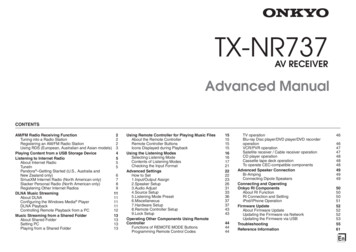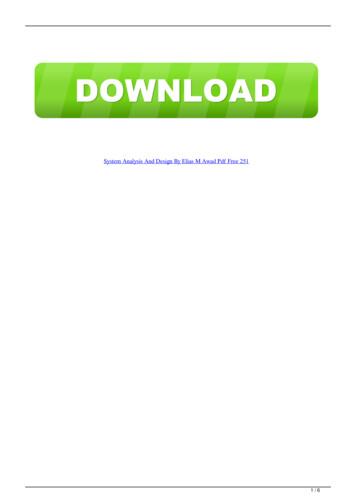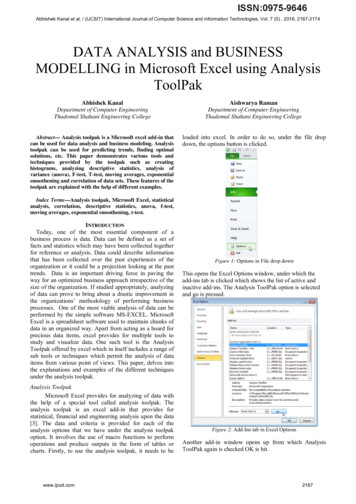
Transcription
Design, Operation, and Data Analysis for a WirelinePacker System in Open Boreholes, with Field-TestResults from Belvidere, IllinoisBy F.L Paillet1 , A.E. Hess2, and J.H. Williams3U.S. Geological SurveyOpen-File Report 98-413Denver, Colorado19981. U.S. Geological Survey, Denver, Colorado2. Alyce Engineering, Louisville, Colorado3. U.S. Geological Survey, Troy, New York
U.S. DEPARTMENT OF THE INTERIORBRUCE BABBITT, SecretaryU.S. GEOLOGICAL SURVEYThomas J. Casadevall, Acting DirectorThe use of firm, trade, and brand names is for identificationpurposes only and does not constitute endorsement by theU.S. Geological Survey.For additional information write to:Chief, Branch of Regional ResearchU.S. Geological SurveyBox 25046, MS 418Denver Federal CenterDenver, CO 80225Copies of this report can be purchased from:U.S. Geological SurveyBranch of Information ServicesBox 25286Denver, CO 80225-0286
CONTENTSAbstract. Introduction.Design and Operation of the Wireline Packer.Analysis of Packer Data.Description of Numerical Model.Graphical Representation of Data.Sensitivity Analysis.Wkeline-Packer Field Tests. Measured Water Levels.Model Results. Interpretation of Results.Conclusions.References. 1115578111117172223FIGURES1. Diagram showing wireline-packer system for water-level measurement .2. Graph showing transient changes in water level recorded by differential transducer and upper water-levelmonitoring system during a measurement cycle at the 115-foot measurement station in borehole T-3 at theBelvidere, Illinois, site .3. Diagram showing steady radical flow along a confined aquifer of transmissivity T from a recharge zonelocated at a radical distance R from a borehole of radius r .4. Schematic illustration showing measured water-level data for the zones above and below the inflated packerand selected well logs; profiles are generated by fitting straight line segments for WLA and WLB betweeninflow zones inferred from inspection of other borehole data .5. Graphs showing effects of variations in transmissivity (T) and hydraulic head (h) on measured water levelsfrom a hypothetical 3-inflow zone interpretation problem: A) all Tk and hk are held constant except for h ;B) all Tk and hk ard held constant except for T2; and C) similar to B except that T! is made very large .6. Graph showing measured water-level rise and differential transducer hydraulic-head pressure when thepacker is inflated below water level in a casing and water is added manually to the top of casing .7. Graphs showing water levels measured in borehole T-l with the wireline packer, borehole flow measuredunder ambient conditions, and selected geophysical logs at the Belvidere, Illinois, site .8. Graphs showing water levels measured in borehole T-3 with the wireline packer, borehole flow measuredunder ambient conditions, and selected geophysical logs at the Belvidere, Illinois, site .9. Graphs showing water levels measured in borehole T-6 with the wireline packer, borehole flow measuredunder ambient conditions, and selected geophysical logs at the Belvidere, Illinois, site .10. Graphs showing model-generated and measured water levels for boreholes T-l, T-2, and T-6 at theBelvidere, Illinois, site .11. Examples of model predictions of water levels for various sets of values of transmissivity (Tk) andhydraulic head (hk) compared to the best fit model given for borehole T-3 in figure 8 .12. Graphs showing (A) relative zone hydraulic head and (B) relative zone transmissivity for the best fitmodel of water-level data in boreholes T-l, T-3, and T-6 at the Belvidere, Illinois, site. Note the break inscale for T values of the fracture zone in borehole T-l and the bedding plane in borehole T-6 .24691012141516182021TABLES1. Wireline-packer test results from Belvidere, Illinois, boreholes .2. Comparison of measured wireline-packer water levels and model predictions .CONTENTS1319III
CONVERSION FACTORSMultiplycubic foot per second (ft /s)foot (ft)inch (in.)mile (mi)square mile (mi )By0.028320.304825.41.6092.590To obtaincubic meter per secondmetermillimeterkilometersquare kilometerDegree Celsius ( C) may be converted to degree Fahrenheit ( F) by using the following equation: F 9/5( C) 32.Degree Fahrenheit ( F) may be converted to degree Celsius ( C) by using the following equation: C 5/9( F-32).Sea level: In this report "sea level" refers to the National Geodetic Vertical Datum of 1929 (NGVD of 1929) a geodetic datum derived froma general adjustment of the first-order level nets of both the United States and Canada, formerly called Sea Level Datum of 1929.IVCONTENTS
Design, Operation, and Data Analysis for a WirelinePacker System in Open Boreholes, with Field-TestResults from Belvidere, IllinoisBy F.L Paillet, A.E. Hess, and J.H. WilliamsAbstractINTRODUCTIONA wireline-operated packer was designedfor use with a standard geophysical logging system. The packer probe consists of a downholepacker inflated with water removed from the borehole by an in-line submersible pump, and a differential pressure transducer calibrated to measurethe hydraulic-head difference between the zonesabove and below the packer. Analysis of thepacker data is based on a numerical model thatpredicts the water levels above and below thepacker for a given set of aquifer zones of specifiedhydraulic head and transmissivity. Various computations are used to indicate the sensitivity of thepacker measurements to the hydraulic head andtransmissivity contrasts between aquifer zones.During investigations of consolidated aquifers, itis often difficult to identify the precise location ofinflow to open boreholes intersecting heterogeneousaquifers where there are many possible inflow zones.The open borehole is also likely to connect zones thatwere previously isolated from each other, allowing forcross-flow and potential contamination of aquifers inthe time period before casing and screens or packersare installed. Furthermore, it is often uncertain whichzones should be isolated from each other with packersor where screens should be installed to sample specificinflow zones connected to large-scale flow paths withinthe regional aquifer.In this report we describe the design, operation,and data analysis for a wireline-operated packer systemfor hydraulic reconnaissance in open boreholes in theperiod immediately after drilling. The wireline packeris designed to produce minimum disturbance to theborehole and can be operated on a standard geophysical logging wireline. Thus, the wireline packer can beconveniently included in a suite of geophysical logsrun as part of the initial aquifer characterization process immediately after drilling. In addition, the reportdescribes the field tests and results of the packer systemin boreholes at Belvidere, Illinois.The wireline-packer probe was field testedin a series of open-bedrock boreholes in Belvidere,Illinois, at a site where vertical hydraulic-head differences are produced in a horizontally stratifiedaquifer by water production from an underlyingaquifer. Analysis of the wireline-packer data produced estimates of hydraulic-head gradient andaquifer-zone transmissivity consistent with resultsfrom straddle-packer hydraulic tests. However,the wireline-packer data also indicated that thereare significant variations of vertical hydraulic gradient with depth, and that the gradient is sharplyreversed near the bottom of the boreholes. Thisresult is consistent with upward ambient flow measured on previous occasions near the bottom ofthese boreholes, and has important consequencesfor the monitoring of ground-water flow at thestudy site.DESIGN AND OPERATION OF THEWIRELINE PACKERThe wireline-packer probe was designed to provide an inflatable packer that could be used to separatea single interval of open borehole into two hydraulically isolated zones above and below a given depth.The packer used in the probe is patterned after a wireline-powered inflatable packer originally developed forthe U.S. Geological Survey (Hess, 1993) as a flow concentrator for a sensitive thermal flowmeter (Hess,1986). The pressure transducer used in the probe is amodified differential-pressure transducer. These coinAbstract
PC CONTROLLEDLOGGING SYSTEMWATER LEVELRECORDERSURFACE CASINGWATER LEVEL IN UPPER ZONELOGGING CABLEWATER LEVEL TRANSDUCERUPPER BOREHOLE ZONEDIFFERENTIAL PRESSURESPACKER CONTROL ELECTRONICSPACKER PUMP & VALVEjiENTRY/EXIT PORT FOR PACKER INFLATION UPPER PRESSURE PORTINFLATED PACKERDIFFERENTIAL PRESSURE TRANSDUCERINSIDE PACKER MANDREL- LOWER PRESSURE PORTLOWER BOREHOLE ZONEFigure 1. Wireline-packer system for water-level measurement.2Design, Operation, and Data Analysis for a Wireline Packer System in Open Boreholes, with Field-Test Results from Belvidere,Illinois.1/98\EPAV
ponents were combined in a logging probe that can beoperated through a single-conductor logging cable (fig.1). The logging system used with the probe for the fieldpart of this study includes the differential-pressure/packer probe, an uphole packer power and controlmodule, a wire-line logger consisting of a winch, logging cable, and winch power and control unit; a PCcontrolled logging and recording system; a separatewater-level transducer and recording system; and anAC power source.The packer is inflated by withdrawing waterfrom the borehole using a submersible pump mountedwithin the probe. This process results in a muchsmaller disturbance to the hydraulic environment in theborehole than that produced when the packer is inflatedusing pressurized gas from the surface (where a volume of water equal to the entire volume of the inflatingpacker is displaced within the borehole).The wireline packer is designed with a sensitivedifferential transducer (Druck, 10 pounds-per-squareinch rated) calibrated in feet of water-level differencebetween the isolated zones above and below the packer.This arrangement provides maximum sensitivity towater-level differences while accommodating largedifferences in hydrostatic loading associated with variations in depth settings of hundreds or even thousandsof feet. A similar sensitive measurement of water levelin the borehole above the packer can be made using atransducer installed just below the largest expectedchanges in water level, and defined with respect to areference point at the surface. These two measurements can then be used to infer the water levels in thetwo open-borehole zones above and below the packerat each measurement station.The differential transducer is mounted inside thepacker portion of the probe. One port of the differentialtransducer is vented to the water above the packer, andthe other transducer port is vented to the water belowthe packer. Thus, the pressure transducer measures thestatic hydraulic-head difference between the zonesabove and below the measurement station when a borehole is sealed by an inflated packer. Electronics withinthe probe transform the output of the differential-pressure transducer into a format suitable for transmissionthrough the logging cable to the surface. The loggingsystem at the surface scales and records the pressureinformation and other logging parameters as a functionof time after each packer inflation. The submersiblepump incorporated in the logging probe is controlledby the packer power and control unit at the surface.Packer pressure is controlled by the logging operatorby regulating the current to the pump.The probe is modular in design to allow otherconfigurations, such as multiple packers or insertion ofa flow measurement device in the center of the probe.Therefore, one or more packers and pressure transducers may be added to the probe, allowing its use as astraddle packer. A borehole flowmeter can be installedin place of the differential-pressure transducer. In sucha configuration, the inflated packer acts as a flow concentrator increasing the sensitivity of flowmeters suchas the heat-pulse (Hess, 1986; 1990) or electromagnetic (Molz and Young, 1993) flowmeters. Thus, a single logging probe could be used as both flowmeter andwireline packer by a simple change of module.Borehole measurements are made with the probestationed at a given depth. Before the packer isinflated, there is no differential pressure between thezones above and below the probe. Any small pressuredifferences registered by the transducer result fromelectronic drift and from response to pressure changesas the probe is moved along the borehole. These errorsare expected to be negligible in most situations. Afterthe packer is inflated, the differential-pressure transducer measures the pressure (hydraulic-head) difference between the borehole zones above and below thepacker. The water-level transducer and recorder measure the change in water-level in the open-boreholezone above the packer after packer inflation. In general, it may take some time for the borehole pressure tostabilize after packer inflation. During this period, differential transducer response in the probe and absolutetransducer response in the upper zone are monitored.The measurements are continued until a steady state isreached, as indicated by steady pressure readings fromthe transducer (fig. 2). In figure 2, the reference for theupper zone water level is defined as zero. The changesin water level that are shown before packer inflationstarts represent a response to packer deflation after theprevious measurement. The offset from zero on thedifferential transducer response in figure 2 representsdrift in transducer response with time. This baselinetransducer response (taken as the average of open-holeresponse measured before inflation and after deflation)is subtracted from the final steady reading given by thedifferential transducer.The data collected with the packer and two transducers provides the steady-state water-level differenceacross the packer, and the upper zone water level ateach packer setting. In conformance with typical meaDESIGN AND OPERATION OF THE WIRELINE PACKER3
DEFLATEINFLATEUPPER ZONEWATER LEVEL0.00101520TIME, IN MINUTESFigure 2. Transient changes in water level recorded by differential transducer and upper water-level monitoring system duringa measurement cycle at the 115-foot measurement station in borehole T-3 at the Belvidere, Illinois, site.4Design, Operation, and Data Analysis for a Wlreline Packer System in Open Boreholes, with Field-Test Results from Belvidere,Illinois.11/97\1\8
surement conventions, we define the water level in theupper zone in feet below the top of casing. The differential transducer provides a positive differential whenthe water level in the upper zone is above that in thelower zone. Thus, the water level in the lower zone isdetermined by subtracting the differential from themeasured water level in the upper zone. Accordingly,final measurement output is given as paired water-leveldepths below a surface reference point.A few comments can be made about the use of asingle packer. It might appear advantageous to isolatea very short test interval with a straddle-packer systemto obtain a direct measurement of the hydraulic head ina specific zone. One then has to make a large numberof measurements to cover a borehole with, for example, a 5-foot straddle-packer spacing. If we make theinterval any longer than that, the logging tool is too bigfor practical use. With the single packer, we can makecoarsely spaced measurements, and then rule out longintervals where there is no effective difference betweenmeasurements. Each of these measurements involves apressure response time determined by the most rapidlyresponding zones in the borehole. In contrast, straddlepacker isolation and testing of individual zones wouldinvolve the testing of many non-conductive zones.Each such test might require many hours. The efficiency of the single packer method in avoiding the testing of most non-responsive intervals is obvious.ANALYSIS OF PACKER DATADescription of Numerical ModelThe steady-state flow (q) into an interval of borehole from a large distance R is given by the equation(Davis and DeWiest, 1966; fig. 3):(1)(1) where Tis the zone transmissivity, h is the far-fieldwater level at the "outer edge" of the zone, HQ is thewater level in the borehole, and r is the boreholeradius. If there are N zones communicating with eachother along a section of open borehole, then the flow ineach such zone (q is given by:k 1,2,3,. .N(2)where the hydraulic head in each zone (hk) may be different from that in the other zones, and from the waterlevel in the borehole. Such a situation allows steadyflow along the borehole, producing the flow needed tosupport the observed head differences between zones.When the borehole is shut in so that N individual zonesare open to the borehole, but there is no net flow into orout of the borehole, then the sum of all these inflowsmust be zero. This requirement insures that thehydraulic head in the shut-in interval is equal to thetransmissivity-weighted average of the heads in theindividual zones.or(3)TTherefore, if we number packer stations sequentially from the bottom of the borehole and assume thatthere are a total of N inflow or outflow zones, we canrelate the measurements made at each packer setting tothe Tk and hk of the zones above and below the packer.We use the convention that setting k denotes packerposition below the kth producing zone. Then there area total of N l possible packer positions (N-l positionsbetween the N zones, and one each above and below allof the zones). At each of these positions, we can maketwo measurements, the water level above and belowthe packer. This is a total of 2(N 1) data points. However, four of these measurements are not independentlyderived. The two packer settings that are either aboveor below all of the producing zones provide two pairsof measurements (water level above and below thepacker) that are not independent. Two of these fourdata points (one in the lower zone when the packer isbelow all producing zones, and one in the upper zonewhen the packer is above all producing zones) aremeaningless. The other two give the same number: theopen-hole water level. Thus, there are a total of2(N l)-4 2N-2 independent measurements, plus theopen-hole water level (best measured before disturbingthe well with the packer tool) for a total of 2N-1 datapoints.The number of measurements provided by thepacker tool can be compared to the number ofunknowns we need to solve for in describing the aquifer. Each producing zone is described (at steady state)ANALYSIS OF PACKER DATA
RECHARGEZONEAQUITARDAQUITARD2r-H h-AQUIFER OFTRANSMISSIVITYTRECHARGEZONEFigure 3. Steady radical flow along a confined aquifer of transmissivity Tfrom a recharge zone located at a radical distance flfrom a borehole of radius r.2ImE6oE "5Iua Qaa9/98\1\'
by two parameters: zone transmissivity (Tk) and theshut-in far-field hydraulic head (hk). Therefore, wehave enough measurements to solve for all but one ofthese. The problem is formulated so as to solve for allof the hydraulic heads (hk) and the Tk values as a multiple of Tj. In the analysis, we use a forward model topredict the water levels above and below each packersetting as a function of specified number of zones (N),the hydraulic head in each zone (hk), and the Tk as multiples of a reference value.In the forward model, we take the water level inthe lower zone (WLBk) as follows:The degree to which the model fits the data isexpressed as the mean square difference between thecomputed water levels and the measured water levels.If we define WLAMi and WLBMj as the measuredwater levels above and below packer station index /,then the root square difference (D) between data andmodel predictions is given by:N(WLBMr WLBi )(WLAMr 2(5A)WLB!WLB2- meaningless (dead zone below all inflow) hjWLB3 (4A)WLBN 1 - open-holewater level.A similar set of equations applies for the waterlevel above each packer setting, except that the calculations are performed from the top of the boreholedown:We then define A as the maximum differencebetween water levels measured during the packerexperiment. A will sometimes be the differencebetween the water level above the packer in the uppermost setting (WLAN) d the water level below thepacker in the next to lowermost setting (WLB2). Inother situations, the water levels may not increase ordecrease systematically with depth between theseuppermost and lowermost settings. In such situations,A is determined by identifying the maximum and minimum water levels within the set of data. Once A isdetermined, the average error (E) in the fit of modelpredictions to the data is given by:E WLAN 1 - meaningless (water isolated from boreholein the zone above all inflow zones)WLAN hNTN-l hN-lT 4- TA 1WLAj (4B)- open-hole water level.These equations are used to compute the sets ofpacker measurements. The model inputs can then beadjusted until the predicted water levels are reasonablyclose to the measured values. The numerical modelsused to fit data described in this report were computedusing a forward modeling program that eventuallycould be installed as part of the data processing capability of the wireline-packer logging system.D(2N-\)A(5B)Graphical Representation of DataThe model computations described by equations1-5 suggest a general scheme for modeling dataobtained with the wireline packer. Because the packeris inflated for each measurement, the data are obtainedat discrete depth stations. In field applications, thewireline packer is used in conjunction with other geophysical logs. The packer measurement stations aredetermined by inspection of other logs to indicate possible inflow points and to identify places where thepacker can effectively seat against a smooth boreholewall. We expect that there will be no difference inWLA or WLB measurements whenever the packer isset either above or below all of the inflow zones. In thatsituation, one side of the differential transducer is opento all of the producing zones and registers the openANALYSIS OF PACKER DATA
hole water level. The other side of the differentialtransducer is not connected to any producing zone andso remains fixed at the last water level to which it wasexposed before seating of the packer. That water levelis assumed to be the same open-hole water level. Thus,both wireline packer measurements (WLA and WLB)would coincide with the open-hole water level at alldepth stations above and below the producing zones.In the intervening interval, the water levels above andbelow the packer may differ, and this pattern of separation of the WLA and WLB data gives informationabout the transmissivity and hydraulic heads of theindividual producing zones.We propose that the wireline data be presented asindicated in figure 4. The measurements are given asdiscrete data points at specific depth stations. At leastone and possibly several such data points are obtainedat depth stations between each suspected inflow point.The data points are then fit to a series of straight-linesegments coinciding with the depth intervals betweenproducing zones. The straight line segments are joinedby either discontinuous "jumps" for discrete beddingplane and fracture inflow zones, or by "ramps" coinciding with permeable bed inflow zones as shown in figure4. The numerical interpretation consists of finding thebest model fit of the hk and Tk for N possible inflowzones. The model predicts the water levels given bythe straight line segments in figure 4. An effective software graphics system would overlay predicted line segments on the data as a visual cue in data analysis,allowing the analysis to identify the model profiles forWLA and WLB that match the data.SENSITIVITY ANALYSISThe simplest example of wireline-packer measurements would be in a borehole connecting two otherwise isolated permeable zones. However, this is anoversimplified situation because the single packer isolates the two zones whenever the packer is set at adepth between the locations where these zones intersect the borehole. The water-level measurementsabove and below the packer would give direct measurements of the water levels in the two zones:WLA H2(6A)WLB 8where WLA and WLB are the water levels measuredabove and below the packer whenever it is set in theinterval between the two zones. The ratio of the transmissivity values for the two zones would be given by:WLA-WLWL-WLB(7)where WL denotes the water level in the open borehole.A more challenging application of the packerdata occurs when there are three or more zones intersecting the borehole. In the three-producing-zone situation, the water levels in the uppermost and lowermostzones are still directly measured by the wirelinepacker:WLB2 hj(6B)WLA3 h3The sensitivity of the measured WLA and WLBvalues to the intermediate parameters (h2 and T2) isinvestigated by computing the profiles of WLA andWLB that would be measured under various conditions(fig. 5). These simple examples are presented as profiles of WLA and WLB as a function of depth along theborehole for effective comparison with other logs. Thevalues are constant over intervals where there is noinflow to the borehole, and jump abruptly in the intervals where water-producing features, indicated as bedding plane fractures, intersect the borehole.Sensitivity computations show that as long as theintermediate fracture has a transmissivity approximately equal to that of the other two zones (fig. 5 A), thepresence of a water-producing fracture is always indicated by the water-level data. The "step" in the waterlevel profiles is always obvious in the data whether h2is intermediate to the other two values, or equal toeither one (fig. 5 A). The "step" in the profile shiftsfrom one side to the other, but always occurs in thedata.However, when the transmissivity of the intermediatefracture (T2) becomes more than one order of magnitude smaller than the other two T values, the step in theprofile becomes very small. The results in figure 5Bindicate that the presence of the intermediate fracturewould probably not be detected if the T of the intermediate fracture is more than one order of magnitude lessA Wireline Packer for Hydraulic Reconnaissance in Open Boreholes
D)0)OTD)2OTD)D)(DCOOo.T3O) COT3 15C T3O DI! D o C0: 1 5c"- O110) O.n w-D.Es5 lO T392T3 C D2 DW «ro S133d Nl 'Hld3QO) Dil EANALYSIS OF PACKER DATA9
ACALIPERTELEVIEWERWATER LEVELWATER LEVELWATER LEVEL302520DEPTH BELOWSURFACE, IN FEET302520DEPTH BELOWSURFACE. IN FEET302520DEPTH BELOWSURFACE, IN FEETWATER LEVELWATER LEVELWATER LEVELWATER LEVEL302520DEPTH BELOWSURFACE. IN FEET302520DEPTH BELOWSURFACE. IN FEET302520DEPTH BELOWSURFACE, IN FEET302520DEPTH BELOWSURFACE. IN FEETWATER LEVELh2 h 1 2060K 3 -- 80K 2 -100302520DEPTH BELOWSURFACE, IN FEETBT 1 T3CALIPERTELEVIEWER60K 3 --. 80K 2 -100K 1 -T1 10T3CALIPER60. ] - 80 -' : »-TELEVIEWERVHMK 3 -MMK 2 - 20h3 30WATER LEVELWATER LEVELWATER LEVELWATER LEVEL302520DEPTH BELOWSURFACE, IN FEET302520DEPTH BELOWSURFACE, IN FEET302520DEPTH BELOWSURFACE, IN FEET302520DEPTH BELOWSURFACE, IN FEET-"1004rK 1 .-,,-Figure 5. Effects of variations in transmissivity (T) and hydraulic head (h) on measured water levels from a hypothetical 3inflow zone interpretation problem: A) all Tj and hj are held constant except for h2; B) all Tk and hj are held constant exceptfor T2; and C) similar to B except that T-i is made very large.10Design, Operation, and Data Analysis for a Wireline Packer System in Open Boreholes, with Field-Test Results from Belvidere,Illinois.
than the T of the other two fractures. In some situations, one highly transmissive fracture presents a Tvalue orders of magnitude greater than all of the otherproducing zones (fig. 5C). In that situation, the presence of one such highly transmissive fracture does notpreclude the detection of other f
the hydraulic-head difference between the zones above and below the packer. Analysis of the packer data is based on a numerical model that predicts the water levels above and below the packer for a given set of aquifer zones of specified hydraulic head and transmissivity. Various c











